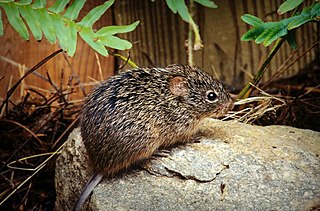
The rodent subfamily Sigmodontinae includes New World rats and mice, with at least 376 species. Many authorities include the Neotominae and Tylomyinae as part of a larger definition of Sigmodontinae. When those genera are included, the species count numbers at least 508. Their distribution includes much of the New World, but the genera are predominantly South American, such as brucies. They invaded South America from Central America as part of the Great American Interchange near the end of the Miocene, about 5 million years ago. Sigmodontines proceeded to diversify explosively in the formerly isolated continent. They inhabit many of the same ecological niches that the Murinae occupy in the Old World.
The Andean rat, or white-tailed akodont, is the only species in the genus Lenoxus. It is a rodent in the tribe Akodontini found on the eastern slopes of the Andes of eastern Peru and western Bolivia. Examination of its genome shows that this species is not closely related to Oxymycterus as had previously been thought, but is quite distinct, having diverged from the other Akodontini soon after the basal radiation of the entire group.

Oxymycterus is the genus of hocicudos. They are rat-like animals endemic to South America. As of April 2019 it included 16 species.
The Amazonian hocicudo is a species of rodent in the family Cricetidae from South America. It is found in the Amazon basin in Brazil where it lives in moist lowland forest. It is a common species with a large range and is rated by the IUCN as being of "least concern".
The angular hocicudo is a rodent species from South America. It is found in Brazil.
The Caparaó hocicudo is a rodent species from South America. It is endemic to Brazil where it is found in the Pico da Bandeira mountain range.
The hispid hocicudo is a rodent species from South America. It is found in Argentina and Brazil, in the Atlantic Forest.
Robert's hocicudo is a rodent species from South America. It is found in Brazil and Paraguay.
The red hocicudo is a rodent species from South America. It is found in Argentina, Brazil and Uruguay.
The Argentine hocicudo is a species of rodent in the family Cricetidae. It is found only in northern Argentina in yungas habitat. The exact population is unknown as only three specimens have been collected and threats may be deforestation and overgrazing although the exact effects are unknown. Some authorities consider it to be conspecific with Oxymycterus paramensis, while others consider it distinct.
The spy hocicudo is a species of rodent in the family Cricetidae. It is found only in Paraguay.
Oxymycterus hucucha, also known as the Quechuan Hocicudo, is a species of rodent in the genus Oxymycterus of family Cricetidae from South America. It is found only in a small region of the Andes in central Bolivia, where it lives in cloud forest at altitudes from 2600 to 3000 m.
The Incan hocicudo is a species of rodent in the family Cricetidae. It is found in Bolivia and Peru.
The Paramo hocicudo is a species of rodent in the family Cricetidae. It is found in Argentina, Bolivia, and Peru. The Argentine hocicudo is sometimes considered conspecific.
The northern rock mouse is a species of rodent in the family Cricetidae. It is found in Mexico and the United States.
Hyperolius nasutus is a species of frog in the family Hyperoliidae. Common names include long-nosed reed frog, sharp-nosed reed frog and long reed frog. It is known from northern Angola and northern Botswana, but it presumably occurs more widely. The nominal Hyperolius nasutus was partitioned in 2013 into three cryptic species, the other two being Hyperolius viridis and Hyperolius microps. All these species are members of the so-called Hyperolius nasutus species group, the "long reed frogs".
The Atlantic Forest hocicudo is a species of rodent in the family Cricetidae. It is found only in southeastern Brazil, where it lives in the Atlantic Forest and associated wetlands at altitudes from sea level to 800 m.
Cook's hocicudo is a species of rodent in the family Cricetidae. It is found only in southern Uruguay, where it lives in wetlands, moist grasslands and scrub. The specifies is named after American zoologist Joseph “José” A. Cook.



